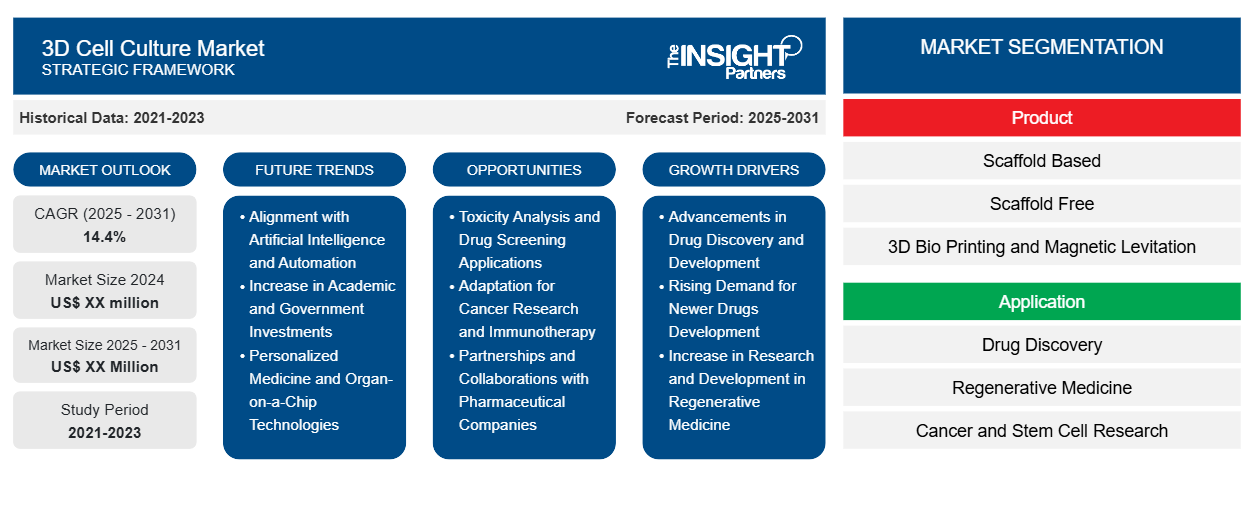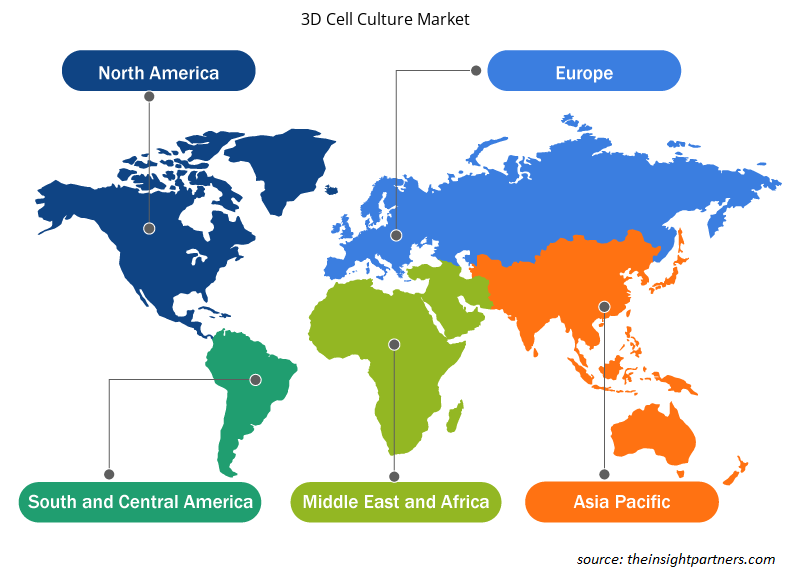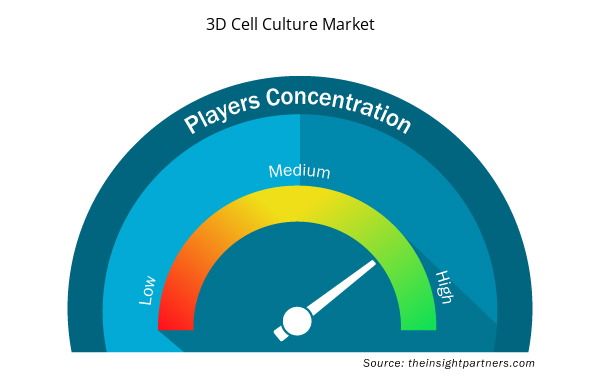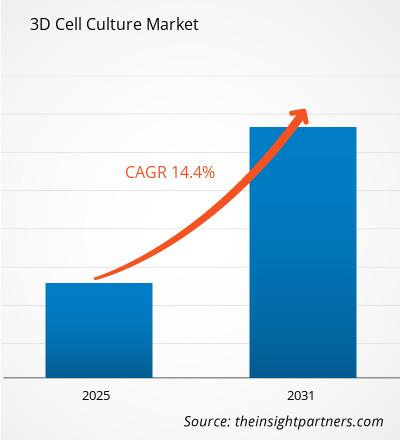The 3D Cell Culture Market is expected to register a CAGR of 14.4% from 2025 to 2031, with a market size expanding from US$ XX million in 2024 to US$ XX Million by 2031.
3D Cell Culture Market report studies market by technology, application, and region. The regional segmentation of major markets and countries gives an international outlook of the market. Market analysis in US$ (for reference), which is used in the report, gives you a detailed understanding of the growth, competition and market dynamics in each segment. This data helps stakeholders take better decision and determine opportunities in the booming 3D cell culture market.
Purpose of the Report
The report 3D Cell Culture Market by The Insight Partners aims to describe the present landscape and future growth, top driving factors, challenges, and opportunities. This will provide insights to various business stakeholders, such as:
- Technology Providers/Manufacturers: To understand the evolving market dynamics and know the potential growth opportunities, enabling them to make informed strategic decisions.
- Investors: To conduct a comprehensive trend analysis regarding the market growth rate, market financial projections, and opportunities that exist across the value chain.
- Regulatory bodies: To regulate policies and police activities in the market with the aim of minimizing abuse, preserving investor trust and confidence, and upholding the integrity and stability of the market.
3D Cell Culture Market Segmentation
Product
- Scaffold Based
- Scaffold Free
- 3D Bio Printing and Magnetic Levitation
- Microfluidics Based
Application
- Drug Discovery
- Regenerative Medicine
- Cancer and Stem Cell Research
End User
- Biotechnological and Pharmaceutical Institutes
- Research Institutes
Geography
- North America
- Europe
- Asia-Pacific
- South and Central America
- Middle East and Africa
Customize This Report To Suit Your Requirement
You will get customization on any report - free of charge - including parts of this report, or country-level analysis, Excel Data pack, as well as avail great offers and discounts for start-ups & universities
3D Cell Culture Market: Strategic Insights

- Get Top Key Market Trends of this report.This FREE sample will include data analysis, ranging from market trends to estimates and forecasts.
3D Cell Culture Market Growth Drivers
- Advancements in Drug Discovery and Development: Traditional 2D cell cultures do not effectively replicate the complexity of human tissues, leading to less accurate results. 3D cell cultures are becoming more popular for drug screening and disease modeling because they provide better representation of in vivo conditions.
- Rising Demand for Newer Drugs Development:This need to have high-end drug development methods is the key driver for the 3D cell culture market. 2D cell cultures cannot accurately simulate complex cellular environments found in the body so 3D cell cultures can be a better option for drug testing and disease modeling. Drug toxicity and efficacy are better predicted with the help of 3D cell culture systems. Research from the National Institutes of Health (NIH) found that 95% of drug candidates are lost to clinical trials due to inadequate test models indicating the need for 3D cell culture models in the pharmaceutical field. This is driving 3D Cell Culture market demand because drug developers turn to 3D cultures for their more accurate testing.
- Increase in Research and Development in Regenerative Medicine: A second reason is the huge increase in research and development in regenerative medicine. 3D cell cultures enable more accurate simulations of human tissues and organs for stem cell therapy, tissue engineering and organ regeneration. With the growth of global research in regenerative medicine, more and more people will need 3D cell culture infrastructure for accurate and precise results. The International Stem Cell Society says that the world stem cell therapy market will exceed $100 billion by 2030, driving the development of 3D cell cultures for regenerative therapies.
3D Cell Culture Market Future Trends
- Alignment with Artificial Intelligence and Automation:
One of the most upcoming future trends for the 3D cell culture market is Artificial Intelligence (AI) and automation. It is applied to massive datasets produced by 3D cell culture experiments to increase the precision of the results and expedite the drug discovery. The automation technologies, too, are making 3D cell culture cultivation, imaging and analysis of cells more scalable and human error-free. As per the National Institutes of Health’s report, AI-based drug discovery models can shorten the time to market for new drugs by up to 50 %, this development will be extremely important for the growth of the 3D cell culture market. - Increase in Academic and Government Investments: There is growing investment from academic institutions and government organizations in 3D cell culture research, particularly for the development of disease models, drug testing, and personalized medicine.
- Personalized Medicine and Organ-on-a-Chip Technologies:
As personalized medicine accelerates, 3D cell culture platforms are being used to make patient models. They’re also being tapped for organ-on-a-chip technologies, which simulate the human organ setting to test drugs or create therapies based on a person’s genetic make-up. Such development will change the way drugs are tested because it gives us more precise models of human disease and treatment response. The Food and Drug Administration (FDA) says organ-on-a-chip models are promising as they can eliminate animal testing and estimate the efficacy of a drug better, making them a leading force in the 3D cell culture market.
3D Cell Culture Market Opportunities
- Toxicity Analysis and Drug Screening Applications: Toxicity testing and drug screening are huge applications for the 3D cell culture market. And, with pharmaceutical firms looking for cheaper and more efficacious methods than animals, 3D cell cultures are also used to validate the toxicity and effectiveness of new medications. They are more reliable and consistent because they are more like the responses of human tissue. And now that the U.S. Environmental Protection Agency (EPA) has announced that 3D cell culture models can be used to reduce animal testing, they are getting more and more use in toxicity testing. This opens up huge market for development, especially in the drug and biotech industry.
- Adaptation for Cancer Research and Immunotherapy: Cancer research and immunotherapy are other lucrative applications of the 3D cell culture market. 3D cultures also make for a better tumor model for studying cancer cell behavior and trialing possible treatments, such as immunotherapies. As immunotherapy is the next important cancer treatment, the need for more powerful models to analyze immune responses will drive 3D cell cultures. Immunotherapies, as the American Cancer Society reports, ‘have extended survival in cancers such as melanoma and non-small cell lung cancer, making the clinical use of better models of cancer even more urgent’.
- Partnerships and Collaborations with Pharmaceutical Companies: Pharmaceutical companies are increasingly recognizing the value of 3D cell culture systems in the drug development process.
3D Cell Culture Market Regional Insights
The regional trends and factors influencing the 3D Cell Culture Market throughout the forecast period have been thoroughly explained by the analysts at Insight Partners. This section also discusses 3D Cell Culture Market segments and geography across North America, Europe, Asia Pacific, Middle East and Africa, and South and Central America.

- Get the Regional Specific Data for 3D Cell Culture Market
3D Cell Culture Market Report Scope
| Report Attribute | Details |
|---|---|
| Market size in 2024 | US$ XX million |
| Market Size by 2031 | US$ XX Million |
| Global CAGR (2025 - 2031) | 14.4% |
| Historical Data | 2021-2023 |
| Forecast period | 2025-2031 |
| Segments Covered |
By Product
|
| Regions and Countries Covered | North America
|
| Market leaders and key company profiles |
3D Cell Culture Market Players Density: Understanding Its Impact on Business Dynamics
The 3D Cell Culture Market market is growing rapidly, driven by increasing end-user demand due to factors such as evolving consumer preferences, technological advancements, and greater awareness of the product's benefits. As demand rises, businesses are expanding their offerings, innovating to meet consumer needs, and capitalizing on emerging trends, which further fuels market growth.
Market players density refers to the distribution of firms or companies operating within a particular market or industry. It indicates how many competitors (market players) are present in a given market space relative to its size or total market value.
Major Companies operating in the 3D Cell Culture Market are:
- Merck KGaA
- KURARAY CO., LTD
- Corning Incorporated
- Lonza
- Thermo Fisher Scientific, Inc.
Disclaimer: The companies listed above are not ranked in any particular order.

- Get the 3D Cell Culture Market top key players overview
Key Selling Points
- Comprehensive Coverage: The report comprehensively covers the analysis of products, services, types, and end users of the 3D Cell Culture Market, providing a holistic landscape.
- Expert Analysis: The report is compiled based on the in-depth understanding of industry experts and analysts.
- Up-to-date Information: The report assures business relevance due to its coverage of recent information and data trends.
- Customization Options: This report can be customized to cater to specific client requirements and suit the business strategies aptly.
The research report on the 3D Cell Culture Market can, therefore, help spearhead the trail of decoding and understanding the industry scenario and growth prospects. Although there can be a few valid concerns, the overall benefits of this report tend to outweigh the disadvantages.
- Historical Analysis (2 Years), Base Year, Forecast (7 Years) with CAGR
- PEST and SWOT Analysis
- Market Size Value / Volume - Global, Regional, Country
- Industry and Competitive Landscape
- Excel Dataset


- Queue Management System Market
- Enzymatic DNA Synthesis Market
- Grant Management Software Market
- Joint Pain Injection Market
- Digital Language Learning Market
- Travel Vaccines Market
- Clinical Trial Supplies Market
- Equipment Rental Software Market
- Arterial Blood Gas Kits Market
- Battery Testing Equipment Market

Report Coverage
Revenue forecast, Company Analysis, Industry landscape, Growth factors, and Trends

Segment Covered
This text is related
to segments covered.

Regional Scope
North America, Europe, Asia Pacific, Middle East & Africa, South & Central America

Country Scope
This text is related
to country scope.
Frequently Asked Questions
Some of the customization options available based on request are additional 3-5 company profiles and country-specific analysis of 3-5 countries of your choice. Customizations are to be requested/discussed before making final order confirmation, as our team would review the same and check the feasibility.
The report can be delivered in PDF/PPT format; we can also share excel dataset based on the request.
Merck KGaA, KURARAY CO LTD, Corning Incorporated, Lonza, Thermo Fisher Scientific Inc, SYNTHECON INCORPORATED, REPROCELL Inc, 3D Biotek LLC, Nano3D Biosciences Inc - are leading companies in this market
The market is expected to register a CAGR of 14.4% during 2023-2031.
The 3D cell culture market is driven by the increasing need for newer drugs, more accurate toxicity testing, and regenerative medicine studies with greater efficacy and disease models.
The 3D cell culture market is being driven by a need for more effective drug development, accurate toxicity testing and research in regenerative medicine, improving drug efficacy and disease modelling.
Trends and growth analysis reports related to Life Sciences : READ MORE..
1. Merck KGaA
2. KURARAY CO., LTD
3. Corning Incorporated
4. Lonza
5. Thermo Fisher Scientific, Inc.
6. SYNTHECON, INCORPORATED,
7. REPROCELL Inc.
8. 3D Biotek LLC.
9. Nano3D Biosciences, Inc.
10. MIMETAS
11. TissUse
12. InSphero
13. CN Bio
14. Hamilton Company
15. Advanced BioMatrix

 Get Free Sample For
Get Free Sample For